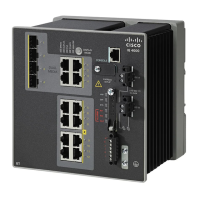• Verify the cable type. See Cable and Connectors, on page 61.
SFP Module
Use only Cisco SFP modules. Each Cisco module has an internal serial EEPROM that is encoded with security
information. This encoding verifies that the module meets the requirements for the switch.
• Inspect the SFP module. Exchange the suspect module with a known good module.
• Verify that the module is supported on this platform. (The switch release notes on Cisco.com list the SFP
modules that the switch supports.)
• Use the show interfaces command to see if the port or module is error-disabled, disabled, or shutdown.
Reenable the port if needed.
• Make sure that all fiber-optic connections are clean and securely connected.
Interface Settings
Verify that the interface is not disabled or powered off. If an interface is manually shut down on either side
of the link, it does not come up until you reenable the interface. Use the show interfaces command to see if
the interface is error-disabled, disabled, or shut down on either side of the connection. If needed, reenable the
interface
Ping End Device
Ping from the directly connected switch first, and then work your way back port by port, interface by interface,
trunk by trunk, until you find the source of the connectivity issue. Make sure that each switch can identify
the end device MAC address in its Content-Addressable Memory (CAM) table.
Spanning Tree Loops
STP loops can cause serious performance issues that look like port or interface problems.
A unidirectional link can cause loops. It occurs when the traffic sent by the switch is received by the neighbor,
but the traffic from the neighbor is not received by the switch. A broken cable, other cabling problems, or a
port issue can cause this one-way communication.
You can enable UniDirectional Link Detection (UDLD) on the switch to help identify unidirectional link
problems. For information about enabling UDLD on the switch, see the “Understanding UDLD” section in
the switch software configuration guide on Cisco.com.
Switch Performance
This section contains the following:
Speed, Duplex, and Autonegotiation
Port statistics that show a large number of alignment errors, frame check sequence (FCS), or late-collisions
errors, might mean a speed or duplex mismatch.
A common issue occurs when duplex and speed settings are mismatched between two switches, between a
switch and a router, or between the switch and a workstation or server. Mismatches can happen when manually
setting the speed and duplex or from autonegotiation issues between the two devices.
Cisco IE 4010 Switch Hardware Installation Guide
51
Troubleshooting
SFP Module

